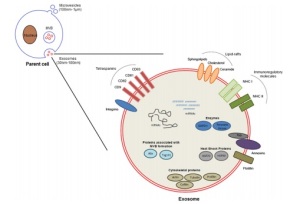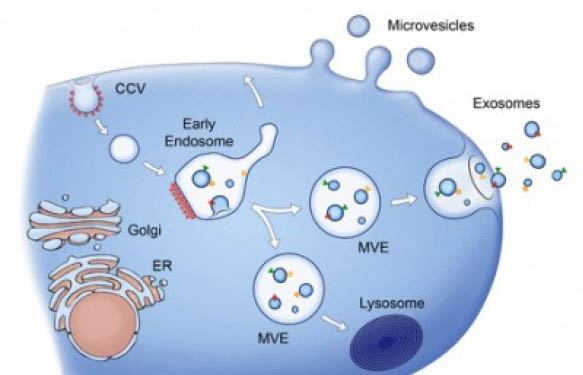Following our series of posts on the role of exosomes in cancer (TME, signaling), let’s have a look at Neurobiology today. Because exosomes are everywhere (even in beer!).

Years ago, exosomes were considered as ‘extracellular debris’, but in fact they are mediators of intercellular communication by delivering functional proteins, mRNA transcripts and miRNA to recipient cells. In Neurobiology, it has been suggested that they primarily serve as signaling organelles which also remove unwanted cellular components in the brain. However, accumulating evidence suggests that exosomes can also contribute, significantly, to the development of several neuropathologies.
For example, exosomes secreted by resident brain cells in response to pathogenic stimuli, such as viral proteins, can also influence bystander cells by the transfer of dysregulated miRNAs that supress the expression of essential genes in the recipient cells. Exosomes may alter the way we think about brain disorders and their treatments (1).

Also, toxic forms of aggregated proteins such as α-synuclein, amyloid β and prions (responsible for Parkinson’s, Alzheimer’s and CJD, respectively) are packaged into exosomes and spread out from one cell to another, initiating an inflammatory cascade. Similar findings have been shown in other diseases such as multiple sclerosis, brain tumours (e.g. glioblastoma) and schizophrenia (2). Exosomes containing “toxic” or misfolded proteins can cross the blood-brain barrier, meaning that they can also be used as delivery vehicles of drugs and genetic elements in the treatment of immune, psychiatric and neurologic disorders (3).
Another therapeutic use for exosomes is using them as they are, without modifications. One example includes multiple sclerosis (4). Dendritic cells from bone marrow can be cultured and stimulated to release exosomes. When administered to the brain, these exosomes significantly increase myelnation and improve remyelination following injury by prompting preoligodendrocytes to differentiate into myelin producing cells. This treatment has the advantage of lacking harmful side effects normally associated to current immunosupressive therapies for this disease.
All in all, it seems clear that in Neurobiology, study of the exosome content may be crucial to better understanding the onset and progression of a high variety of diseases, as well as using them as therapy. Exosome content includes mRNA, proteins, cytokines, miRNA…(5). Discovering the specific cytokines or miRNAs present in exosomes usually requires profiling techniques, so that all possible markers can be detected.
In spite of major advancements, especially in 2014, research of exosomes in Neurobiology is still at its infancy. We look forward to the great discoveries in this area that lay ahead!
References
1.- Gupta, A. & Pulliam, L. (2014). Journal of Neuroinflammation, 11:68. http://www.jneuroinflammation.com/content/11/1/68.
2.- Tsilioni, I. et al. (2014). Clinical Therapeutics/Volume 36, Number 6, 2014. DOI: http://dx.doi.org/10.1016/j.clinthera.2014.05.005.
3.- Aryani, A. & Denecke, D. (2014). Molecular Neurobiology, December 2014. DOI 10.1007/s12035-014-9054-5.
4.- Pusic, A.D. et al. (2014). Expert Rev. Neurother. 14(4), 353–355 (2014). doi: 10.1586/14737175.2014.890893.
5.- Sampey, G.C. et al. (2014). Journal of NeuroVirology, Volume 20, Issue 3 , pp 199-208. doi: 10.1007/s13365-014-0238-6.



